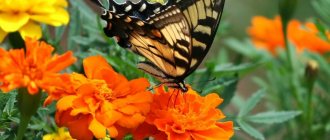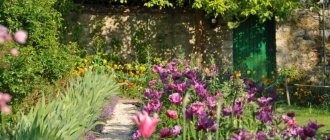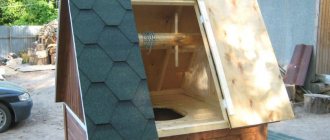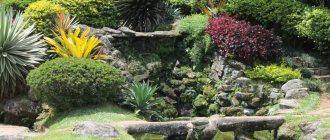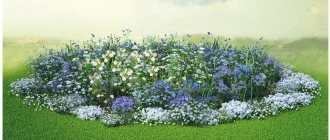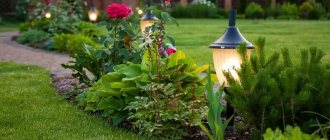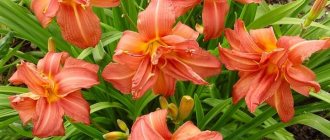How to choose coniferous plants for flower beds
To create a mixborder with conifers, you need to use planting schemes and correctly combine several options.
To create a flowerbed composition, you do not need to use all the available conifers. Small-sized varieties are used that will not overlap with their dimensions other components of the composition.
Therefore, junipers, dwarf firs and low pines will be good options for a personal plot.
When it is necessary to create a plant border, then tall cypress trees are chosen. Stripes of juniper or bush flowers would be good neighbors. This will become a bright green background, and such a fence will protect from prying eyes.
It is recommended to choose coniferous vegetation depending on the type of soil and the characteristics of the site. These parameters are used to determine the place where the composition will be located and the plants from which it will consist.
Conifers for design are divided into the following varieties:
- Pine. These include cedars and spruce.
- Cypress. These are junipers, thujas, cypresses.
- Yew. Yews, torreys.
Tall vegetation is best planted in spacious areas. For this, they use Hoopsie spruce, which has silver-colored needles, Western thuja, which is trimmed to the desired shape, and juniper, which has a blue tint.
Low-growing varieties are suitable for flower bed compositions. They are planted in a geometric sequence. This applies to oriental thuja, mountain pine and pug pine.
To fill the adjacent area and create the correct height arrangement, Cossack or horizontally growing juniper is used.
Flowerbed with thuja and flowers: diagrams
The combination with conifers and perennials will be beautiful if you highlight several accents in combination. Thuja is a low-growing shrub. It can grow up to 1.5 meters. It is better to plant them in the background.
Such an accent can be an independent component and combined with crushed stone or trimmed grass.
A flower bed with conifers and flowers can be shaded with stones. Then the correct proportions are maintained. The scheme is made independently or a ready-made version is used.
It is possible to cut thuja into different shapes. This adds a whimsical touch to the design and accent. This culture can grow both in the sun and develops well in the shade.
To create a mixborder, then thuja conifers are combined with perennial crops of bright edema. Experienced gardeners plant flowers that bloom at different times. This will allow the module to always be in bloom; in winter, thuja conifers will create accents.
A properly designed ridge can also combine these plant crops. It can be located near the fence along with vines. In this case, you will need to arrange all the components according to the area of the ridge.
Advantages
Many people organize beautiful coniferous mixborders on their plots, which allow the garden to look attractive even in winter. But this is not the only function that evergreen shrubs and trees perform within a given flower garden. Why do most gardeners choose them?
Firstly, if a mixborder consists exclusively of conifers, it turns out to be the most unpretentious flower garden, which requires a minimum of time, effort and financial costs. But this does not mean that he does not need care at all. You still need to follow the standard procedures twice a month:
- feeding with fertilizers;
- spraying against diseases and insects;
- removal of damaged branches.
In hot weather - watering. In addition, since the mixborder presupposes a fairly close planting of conifers, rot, fungus, and mildew often form in places where they touch. This is the main and almost the only problem of this flower garden. But if you regularly loosen the soil, remove yellowed needles and branches, and do timely spraying, it can be avoided.
Secondly, the decorative varieties of coniferous shrubs and trees are so diverse that you get a fairly voluminous, multifaceted flower garden. Even if you don't use other garden plants (herbs and flowers), it will still look gorgeous.
Thirdly, conifers allow you to create that gradation, which is one of the main principles of building a mixborder. The background (if it is located near a fence or wall) or the center (if it is organized as an island in the middle of the site) are the tallest plants. And the best among them are the slender, elongated cypress trees. The second layer consists of low-growing shrubs, and here it is difficult to find something more suitable than decorative varieties of mountain pine or thuja. The last row, spreading at the very feet, is the ground cover. And there is plenty to choose from: Wintergold yew, Repanda juniper, etc.
The coniferous mixborder is an excellent solution also because:
- fits into any landscape design style;
- presented in a wide variety of patterns, as it goes well with other ornamental plants: deciduous, flowering, herbaceous;
- looks great with garden sculptures.
According to data, 85% of mixborders include conifers. And now it’s clear why. They seem to have been created by nature itself for this type of flower garden. Without them, it no longer looks so rich and evergreen. So, if you are planning to create one on your site, buy decorative spruce, pine, thuja, cypress and more. Well, we have already talked about how to plant conifers correctly so as not to harm them.
Juniper in a flower bed
A combination of coniferous and ornamental plants can emphasize the beauty of each element. Juniper is often present in such a symbiosis. It is unpretentious in care, it can grow along a vertical surface or the selected varieties can stretch upward. This crop can withstand the cold of northern latitudes and the heat of southern latitudes well.
There is a wide variety of varieties, which allows you to match the desired height and width. Often such a flowerbed of conifers decorates the area near a gate or gate, and can be placed behind a fence in the front garden.
A multi-tiered alpine slide can also be made of juniper. In this case, several varieties of different growth sizes are selected. These conifers are combined with roses or perennial flowers.
When a horizontal arrangement occurs, then you need to arrange it this way:
- Stones are scattered around the perimeter.
- Different varieties of juniper crops are planted between them.
- The boundary of the contour is laid out with small boulders.
Such a composition can be located in the center of the site or closer to its edge.
Blue spruce in composition
This option has a beautiful view in summer and winter. It has a bluish tint and can be combined with other plant crops.
This representative of dwarf trees can be combined with mountain pine and with a design of conifers and shrubs.
The site is chosen to be sunny: such plants do not develop well in the shade. Bright light will be able to highlight the shades of each element in this formation. To create the desired contrast, it is recommended to highlight several main colors.
The spruce tree should be a key figure in the layout. Before planting, it is worth checking how tall it will grow. This will simplify the growth of other crops and support the overall concept of the structure.
The front garden is made up of three elements:
- A spruce tree is planted in the background.
- A juniper type is planted in the middle.
- Foreground – perennials.
Blue spruce goes well in tone with green spaces. Therefore, it is worth considering their joint location.
Arranging such seedlings is simple: in the background there are taller plantings, closer to the edge there are low-growing, dwarf plantings.
Blue spruce can be used as a component of a rock garden. Such a combined coniferous flowerbed can be combined with hydrangea or low-growing barberry. You can also add flowers, spruce and dwarf conifers.
Combining with stones will help create a Mediterranean style in your territory. You can make islands of flowers or greenery.
Flowerbed with thujas and hostas
Such a coniferous mixborder can grow even in the shade. When using a host, it is worth considering that it can direct all its growth force to leaf development if a planting scheme is used. In the shade, this vegetation does not bloom, but will be lush thanks to the leafy crown.
Thuja and hosta go well together. Long conifers are planted in the background, and light and lush hostas are planted in the foreground. You can make a different planting and plant deciduous trees around the tall thuja.
This creates an interesting contrast and emphasizes the difference in shapes. In addition, another circle is made of low-growing flowers: lilies, irises, etc.
If you are setting up a rock garden, then the combination of two vegetation should be ideal in height. For this purpose, dwarf varieties are selected. They will be able to shade flowering bushes.
Mixborder has a planting plan. The main element in it is the thuja bush. It is worth planting the host as a border as an addition to the overall design.
Coniferous mixborder: choosing a location and step-by-step site preparation
On the site for the future flower garden, evaluate:
- soil composition;
- humidity;
- degree of illumination.
For coniferous mixborders, a place that is not too sunny is given. Under scorching rays, the needles burn out and lose their decorative effect. The soil should not be too dry or swampy. If you are planning a mixed border of conifers as a hedge, then it is advisable to place the planting not near the windows - as they grow, large trees will be an obstacle to the view.
It is better to interrupt a strip of a flower bed that is too long without making it continuous. It looks more aesthetically pleasing, and caring for plants will be easier. 0.5 m are set back from the edge of the garden paths.
Helpful advice! When choosing a color scheme for a mixborder, warm shades are mixed with warm ones, and cold ones with cold ones.
The presence of conifers always emphasizes English severity and restraint in a mixborder. In such compositions, too catchy colors and lush shapes with wide leaves are usually avoided.
Coniferous mixborder.
Starting excavation work:
- The site is dug up in the fall, and fertilizers are added if necessary.
- According to ready-made diagrams, holes are made for conifers, shrubs and basic perennials. Distance between low and dwarf forms: 60–80 cm, between medium ones 1–1.5 m, between tall trees at least two meters.
- Lay out decorative elements.
Note! All seedlings are purchased only from trusted nurseries.
While the bushes are growing, in the spring you can plant annual crops: garden balsams, petunia, snapdragons, geraniums, asters.
Features of caring for conifers in a flower bed
Easy-to-care for conifers are often used for plantings. They quickly take root after planting and grow well in the shade and sun. But before planting, it’s worth planting the “neighbors” correctly.
Some vegetation has a developed root system, which can take all the nutrients from the soil, while interfering with the development of other crops.
You should not water these species frequently. Conifers do not like excess moisture and do not develop well in soil that is recharged with water from nearby roof drains. But it’s still worth watering during the dry season. Fertilizing is also done to promote the development of the root system. It is not recommended to use organic fertilizers; it is better to add nitrogen supplements specially designed for this vegetation.
Weeds are removed so that they do not spoil the ridge. Pruning should be done in spring and autumn. Branches that spoil the overall design and those that die are removed.
Dried branches will take nutrients from the soil and trunks. To prevent plantings from becoming infected with fungus, it is recommended to treat them regularly. Disinfectants are used as a preventative measure.
Step-by-step creation instructions
Arranging any flowerbed with your own hands begins with preparing the soil. And in the case of conifers, the soil must be prepared especially carefully, since they are planted once for many years. First, you need to dig the area deeply, since the roots of most coniferous plants are quite long. The soil for conifers should be loose, with good drainage properties, preferably sandy loam with neutral acidity.
After digging, you need to remove all lumps, roots, and weeds from the soil, and apply mineral fertilizers suitable for the specific type of conifers that will be planted in the flowerbed. Peat and sand should be added to heavy clay soil, and a little turf soil to sandy soil. If the flowerbed is small, you can purchase soil for it at a flower shop - they sell ready-made soil mixtures for each individual type of coniferous trees and shrubs.
After the soil in the flowerbed has been prepared, you can begin to design a composition of conifers. Here it is important to transfer the schematic plan of the flowerbed as accurately as possible to a real plot of land.
The process is as follows:
- Outline the boundaries of the flower bed according to the plan.
- Decorate the contours with pre-selected materials: stone, curb bricks, crushed stone.
- Next, use pegs to mark the locations for planting coniferous plants. In this case, you need to correctly calculate the distance between the conifers so that in the future they do not shade or crowd out each other.
- Dig holes (holes) for plants, taking into account the length of the rhizomes: for coniferous trees 60-70 cm, for low-growing shrubs - 40-50 cm.
- Place a layer of crushed stone and sand at the bottom of each hole - this will ensure the circulation of air and moisture in the soil.
- Then add a fertilizer mixture suitable for this type of coniferous plant to each hole.
- Place the seedlings vertically in the hole.
- Fill the hole halfway with soil, then lightly compact it.
- Next, fill in the remaining soil and compact the surface again.
- Now water the conifers thoroughly.
- Cover the wet soil with the remaining soil and level the surface well.
After the coniferous composition is planted, the soil in the flowerbed should be mulched. When choosing a material, it is advisable to take into account not only the decorative properties of the material, but also its practical benefits for plants - organic mulch: fine crushed stone, granite chips, wood chips and sawdust, in addition to the mulching function, also improve the properties of the soil.
